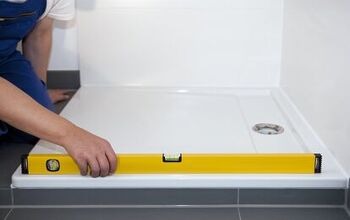Standard Scaffolding Sizes (with Drawings)

A significant part of planning any home improvement project is making sure you have the right tools and supplies for the job. Using the proper equipment can make all the difference in your timeline, safety, and budget. Knowing the standard scaffolding sizes is helpful if you’re planning any projects that require you to work off the ground.
Residential standard scaffolding is 29 inches wide to fit through most doorways, but 54-inch double-wide scaffolding is available. The most common scaffolding lengths are 4, 6, 8, or 10 feet, but you can use extensions if you need them longer. Scaffolding is various heights, but once you reach over 16 feet high, you need to use outriggers for extra support.
If you plan a large project that puts you at least four feet above the ground, you should use scaffolding. You can also find some scaffolding less than 29 inches wide for residential use. Make sure to familiarize yourself with the options so that you can choose the most appropriate scaffolding for your project.
What Are The Three Main Types Of Scaffolding Sizes?
When looking at scaffolding, you’ll run across three main types: supported, suspended, and aerial. Suspended scaffolds hang from above (think of ones you see on large buildings when you see window washers at work).
Aerial scaffolds are on the ground, but workers can raise and lower them, usually with an electric lift. The scaffolding you’ll most likely use for residential use is supported scaffolding.
Supported scaffolding stands on the ground and can consist of multiple levels. It’s what you most likely see when you pass a construction site. When choosing supported standard scaffolding, you’ll have a few sizes to consider.
Standard Scaffolding Sizes By Type
Scaffolding height can vary from under four feet tall to over 20 feet tall. Typically, once you start going higher than 16 feet you need to start adding extra support or bracing. For home projects, you likely wouldn’t need to get this high.
Single Scaffolding
Single-wide scaffolding is a great choice for interior residential projects. Its narrow width makes it easy to fit through doorways and in hallways. Typically, single scaffolding is about 29 inches wide, although some can be even slimmer.
For example, this mini scaffolding unit features an overall width of 22.5 inches and has multiple levels. The design allows the user to easily step from the lower level to the upper level. Each step is roughly 9 inches wide, or you can place them together for one wider step.
Scaffolding lengths can vary based on the manufacturer, but common sizes are 4, 6, 8, or 10 feet. You can find smaller options, like this one, or purchase extensions if you need longer lengths. If you use extensions, the recommendation is to allow a 12-inch overlap for maximum stability.
Double Scaffolding
Double scaffolding has similar lengths and heights as single scaffolding; it’s just wider. Usually, it’s about 54 inches wide, making it difficult to fit through doorways. Therefore, if you were to use double-wide scaffolding for a residential project, it would likely be for exterior work.
The extra width also allows for a higher load capacity and more maneuvering room on the scaffold. Keep these qualities in mind when thinking about your type of project.
Foldable Scaffolding
If you have limited space but need to use scaffolding for a project, consider a folding style. They come in single or double-wide sizes but can be folded down easily when not in use. It’s also a great option if you have multiple projects in different locations.
You can find them in various lengths, including 6 or 8 feet long. However, they could be as slim as 5 to 10 inches when folded, making storage and portability much easier.
What Are the Minimum Sizes for Suspended Scaffolding?
If you plan to use suspended scaffolding, you’ll likely want to go with the smallest size available. After all, you’re using it for your home, not a skyscraper. If you do need suspended scaffolding, your best bet is to rent the scaffolding, as you won’t likely use it often.
The platforms of a two-point suspension scaffold (the most common) should not be wider than 36 inches. The smallest size of suspended scaffolding can vary, with some sizes only fitting one person. But, again, for residential use and DIY projects, you’re likely not going to be using suspended scaffolding.
How Much Does Scaffolding Weigh?
Depending on the size of the scaffolding, the weight can vary. However, some smaller, single-wide units are relatively lightweight.
For example, the portable mini scaffold above weighs 50 pounds. For home projects and interior work, such as painting and typical repairs, this is likely the most common type of scaffold used.
But, a slightly wider and longer scaffold, such as 30 inches wide by 6 feet long, would weigh closer to 125 pounds. But many scaffolding frames come with locking castors, making them easier to move into position.
Obviously, as you start to add height if using stackable scaffolds, you’ll double or triple the weight. If you want a double-wide scaffold, you can place two singles side by side and connect them.
How High Should Scaffolding Be?
Scaffolding should be used any time you work at least four feet off the ground. It can be just three feet tall or go well beyond 16 feet high. The important thing is to know when to use extra support.
When Do You Need To Add Supports to the Scaffold?
Typically rolling scaffolds should not be stacked more than 18 feet high. Portable style scaffolds should be no higher than 12 feet. If your scaffold is 4 feet long, anything over 8.5 feet needs fall protection. At 6 feet long, anything over 9.5 feet requires a harness or fall protection.
If the scaffold is 7 feet long, anything over 13.5 feet needs fall protection. However, if you install outriggers for added support, you increase the working width essentially. Therefore, you reduce the need for restraints.
According to OSHA, a 4-foot scaffold with 2-foot outriggers requires fall protection at over 16 feet. A 6-foot scaffold with the same outriggers requires restraints at over 24 feet. Finally, 7-feet wide scaffolds with outriggers need protection at over 28 feet.
How Far Can Scaffolding Be from the Wall?
Typically, the scaffolding platform should be 14 inches or less away from the wall. If you are doing plaster or stucco work, it should be 18 inches or less away.
You also need a guardrail at a height between 38 and 45 inches. If the front of your scaffold is less than 14 inches from the face of the work, you do not need a guardrail.
Wrapping Up Standard Scaffolding Sizes
The most common types of scaffolding for home DIY work are single and mini scaffolds or folding scaffolds. Single scaffolds are usually less than 29 inches wide to fit through doorways easily. Double wide scaffolds are about 54 inches wide.
You can fold up portable scaffolds for easy storage; some fold as slim as 5 to 10 inches. Heights and lengths can vary based on the scaffold. Typical lengths are between 4 and 10 inches, with extensions available for longer lengths.
If using scaffolding above four feet, you need to employ restraints or fall protection. But if you decide to add outriggers, you can increase the height before needing restraints. Once scaffolds reach 16 feet tall, you must use extra bracing or support.

Stacy Randall is a wife, mother, and freelance writer from NOLA that has always had a love for DIY projects, home organization, and making spaces beautiful. Together with her husband, she has been spending the last several years lovingly renovating her grandparent's former home, making it their own and learning a lot about life along the way.
More by Stacy Randall






























![12 Washing Machine Brands to Avoid [with Recall Data]](https://cdn-fastly.upgradedhome.com/media/2023/07/31/9075781/12-washing-machine-brands-to-avoid-with-recall-data.jpg?size=350x220)

